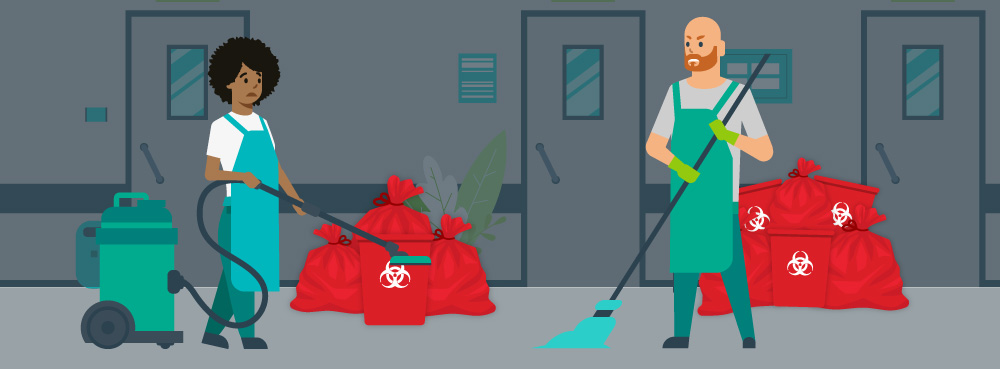Day-To-Day Challenges Facing EVS Professionals in Acute Facilities

Environmental services professionals, or EVS professionals, play a core role in every acute facility. Though often overlooked, these essential frontline workers put themselves at risk every day, ensuring patient and staff safety as well as a high quality of care. Despite the critical role they play in guaranteeing staff and patients safe and sanitary spaces, EVS professionals face a number of day-to-day challenges that complicate their ability to achieve their critical mission.
From a lack of recognition of their contributions and the risks they face in maintaining a clean and safe environment to a lack of training and resources while being forced to take on seemingly ever-expanding duties, EVS professionals must navigate complex challenges every day. The good news is that these struggles have not gone unnoticed, and industry trends are beginning to help lighten the load these professionals face.
TOPICS WE WILL COVER:
1 / Staying Safe and Preventing Injuries to Self and Staff
3 / Inefficient Working Programs
4 / Staying on Task and Avoiding Patient Interruptions
5 / What the Industry is Doing to Support EVS professionals
Staying Safe and Preventing Injuries To Self And Staff
EVS professionals are the first line of defense against the spread of infection, and the COVID-19 pandemic helped shine a light on the risks EVS technicians face on a daily basis in safeguarding against the transmission of infection. EVS workers have the responsibility of cleaning, disinfecting, and removing potentially infectious materials to provide clinical staff and patients with a clean and beneficial care environment.
Contaminated sharps and pharmaceuticals sometimes expose EVS professionals to highly infectious waste materials. Because of this, far too often, EVS professionals face injuries and infections themselves due to a lack of appropriate PPE, unnecessary overhandling of waste, and insufficient containment methods.
Lack of Bandwidth
In acute care facilities, virtually every surface can represent a unique potential for the transmission of infection. EVS professionals often must clean increasingly costly and technical pieces  of equipment while dealing with correspondingly faster rates of patient flow and insufficient training to handle new responsibilities.
of equipment while dealing with correspondingly faster rates of patient flow and insufficient training to handle new responsibilities.
This is all while dealing with their traditional tasks of cleaning and disinfecting patient rooms and treatment areas while removing infectious wastes. In many acute care facilities, EVS professionals must deal with these tasks alongside the additional role of emptying, cleaning, and disinfecting reusable disposal containers.
This all comes together to leave EVS professionals with heavy demands for service with too few resources to meet them.
Inefficient Working Programs
EVS pros often have to deal with poorly set-up work programs & cumbersome bureaucracies to maintain compliance with established standards. Often EVS management is understaffed and simply left to react to situations without the ability to plan or provide input on revising existing workflow. This means EVS workers must spend time on unnecessary tasks or tasks that, if outsourced to external providers, would allow technicians to focus on critical functions.
Staying on Task and Avoiding Patient Interruptions

One of the most common struggles EVS professionals face every day is interruptions in their workflow. From unexpected messes that need to be cleaned up immediately to patients asking them if they can put off removing waste and cleaning up their room until later, it can be difficult for EVS workers to stay on task and manage workflow.
Because the patient always comes first, these alterations to daily schedules are to be expected, but nonetheless there are opportunities to work smarter, not harder, through the deployment of more efficient systems.
What the Industry Is Doing To Support EVS Professionals
The healthcare industry is not ignoring these challenges–innovators are facing them head-on. From modernized training reflective of today’s increased patient hygiene concerns to reimagined waste disposal routines, industry leaders are making EVS professionals’ jobs safer, faster, and more efficient than in years past.
Upgraded Systems and Training
Prioritizing safety starts before medical waste is even created. Healthcare administrators must think ahead to prevent injuries and make wise safety choices. Starting with modern waste disposal designed with the safety of patients and EVS professionals in mind prevents incidents throughout the waste cycle. 
Daniels Health offers medical waste disposal systems made to meet and exceed all applicable safety standards. The bins and containers minimize touches and contact, saving time while also promoting staff safety. Mobile, foot-operated, bagless solutions mean bins can travel where they need to go, so that hazardous waste never has to move far before disposal.
Most importantly, EVS techs reduce touches thanks to the bagless solution. Once a container is full, it can be securely closed and transported for off-site disposal without having to pull out a heavy, easily-penetrable red bag.
Daniels has designed specialized lines of containers like Pharmasmart, Medismart, and Sharpsmart to mitigate the unique risks of the wastes they contain. For example, Sharpsmart containers boast 13 distinctive safety features, offering an up to 87% decrease in needlestick injuries and establishing them as the safest sharps containers in the market. Selecting the right waste disposal products sets healthcare workers up for success.
Of course, containers only function as well as the team who uses them–this is why constantly-updated training is essential to ensure all members of the EVS and clinical teams are familiar with safety practices & proper use of waste disposal systems.
In recent years, patients’ awareness of and demand for safe, clean facilities has tested every facility’s capacity. EVS professionals cannot rely on yesterday’s training but must stay informed on the latest standards for minimizing infection and injury risk while maximizing facility cleanliness.
Ensuring Proper Staffing and Delineation of Duties
Worker attrition and short-staffing have become a constant reality for acute care facilities, and EVS is no exception to this. However, increasing efficiencies have helped to compensate for this and allow EVS to achieve its responsibilities. The first part of this has been examining demand and aligning staffing to periods of highest demand. For example, by ensuring that shift changes occur during slow times instead of busy periods, EVS personnel can be prepared when demand is highest.
Another change has been ensuring that duties are appropriately delineated to verify they are performed by those that can most efficiently perform them. In some cases, this means specializing by allowing personnel to work in the roles they can handle most efficiently, and in some cases, outsourcing functions such as waste containment sterilization to external vendors who can handle it more efficiently.
Improved Planning and Workflow
Interruptions to workflow can prevent EVS professionals from achieving their roles, but new tools such as improved waste management can help to keep them on task. Daniels Health works with personnel in each facility to determine the optimal placement of each waste receptacle. This means creating a map that plans for the movement of waste from its generation to its final pickup.
In addition, bagless wall-mounted containment systems mean less time spent in each patient room and working area. Daniels designs its containers with mobility in mind, with a seamless transition from wall mounts to trolleys and carts. This means less time for the collection and transport of waste and reduced potential for interruptions.
Final Thoughts
EVS professionals face many challenges each and every day, but these struggles have not gone unnoticed. Healthcare professionals and industry partners such as Daniels Health have acknowledged these problems and are working tirelessly to increase safety for EVS teams and provide innovative solutions to help them accomplish their goals of infection control and reduced costs.
Let's Talk!
Your time is valuable, and we don’t want to play hard to get. You can either phone us directly on the details listed on our contact page, or feel free to fill out this short form and one of our team members will get back to you as quickly as possible.
